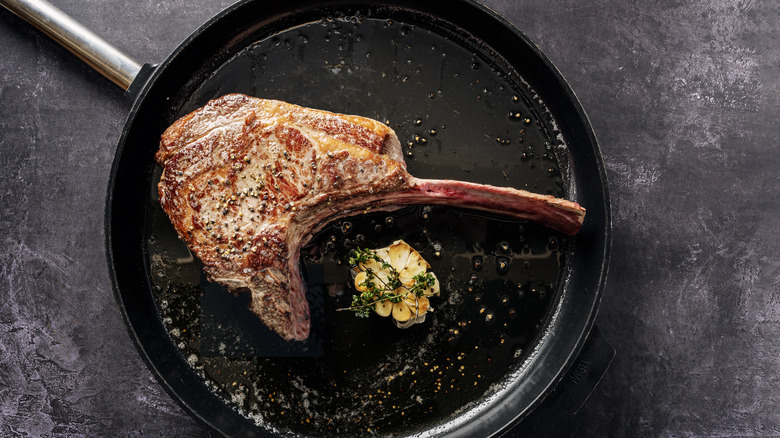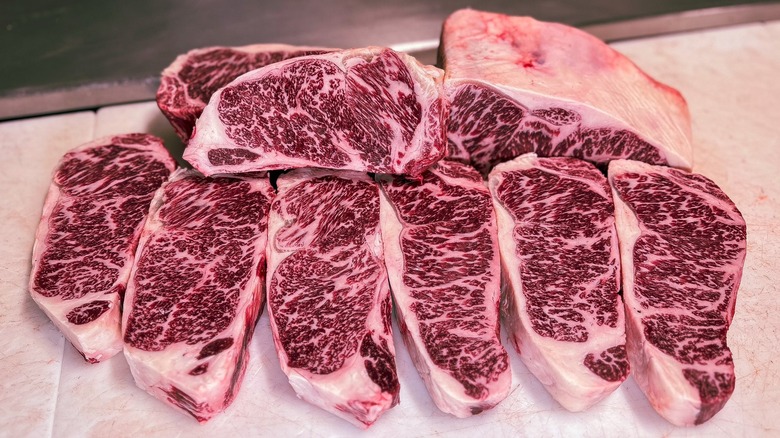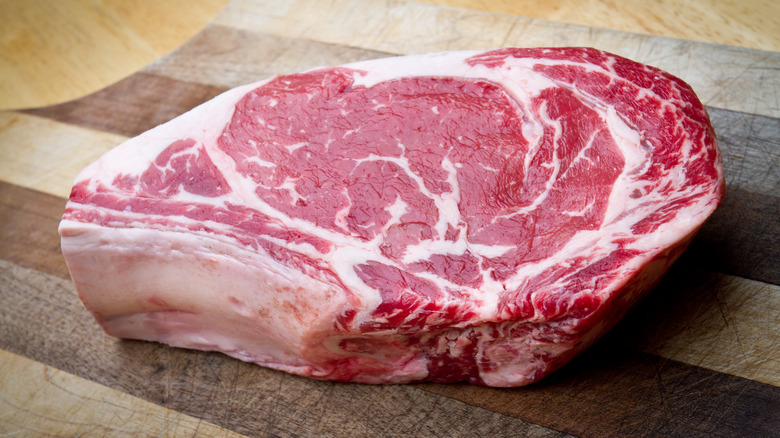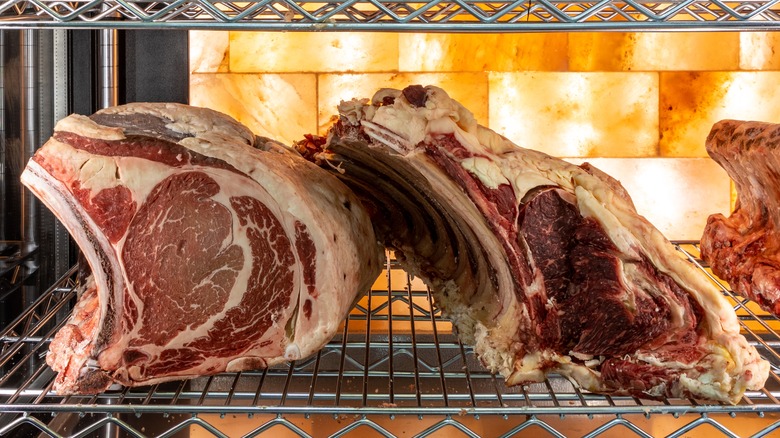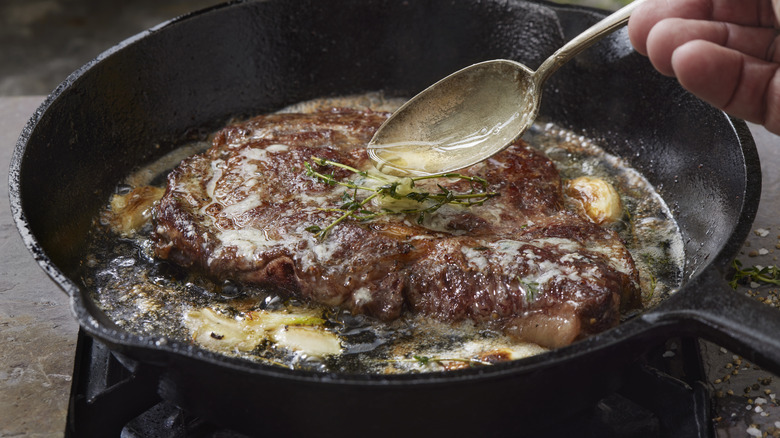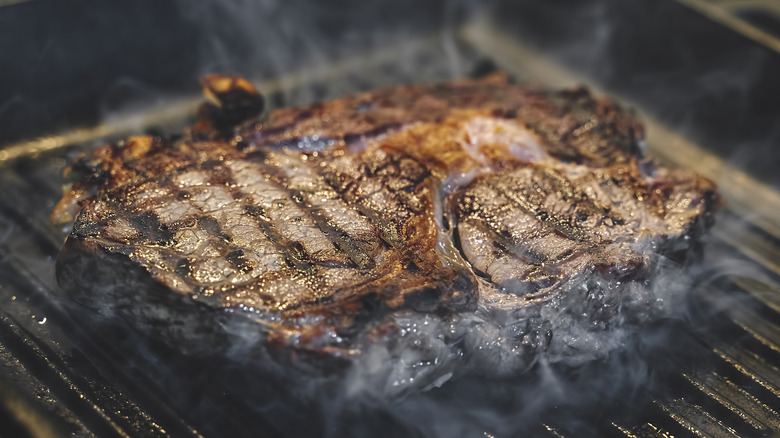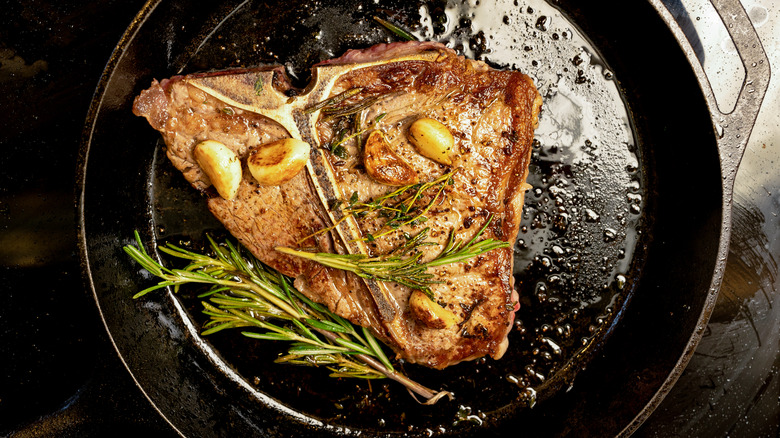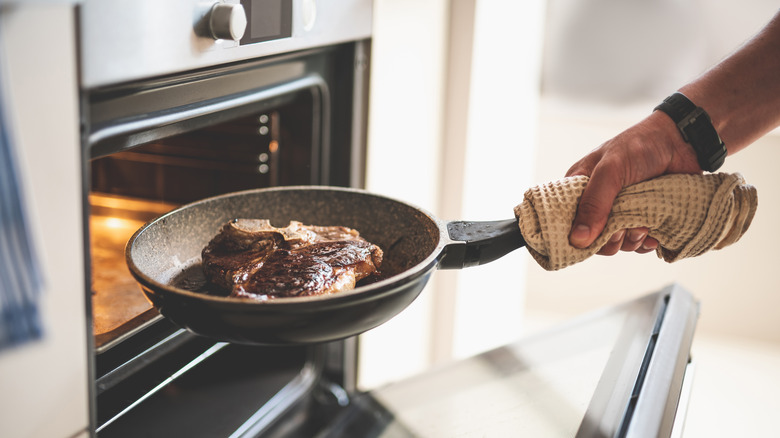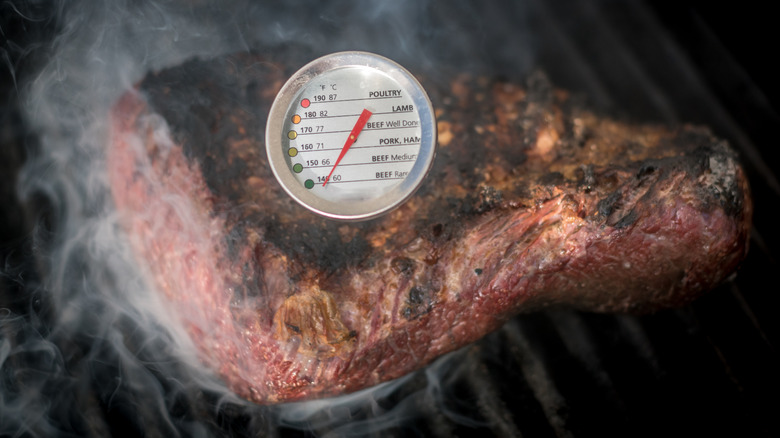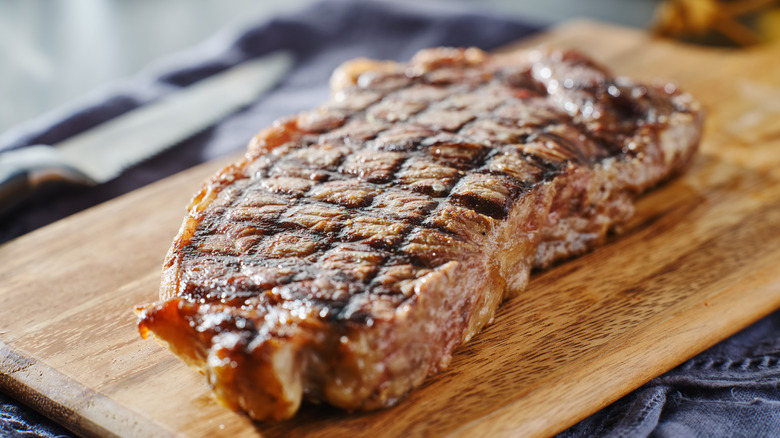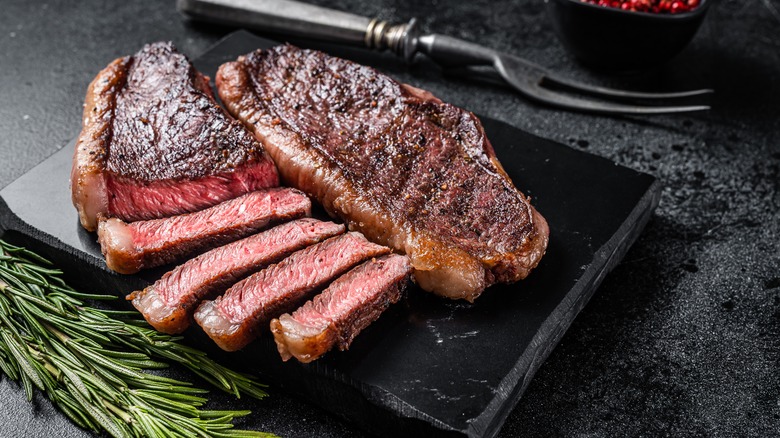11 Tips For Cooking Steakhouse-Style Steaks At Home
Unlike some restaurant food, steak is a relatively simple dish to prepare at home, needing no expensive gadgets and only a basic understanding of cooking techniques. When cooking steak at home, however, the end result can easily fall far short of the meat served at your favorite steakhouse. This is not surprising — steakhouse steaks have been expertly sourced, prepared, and cooked by a team of highly trained individuals. While steak might be simple to cook, it is much more difficult to cook well.
That being said, the benefits of cooking steak at home are many. For one, it's much cheaper than eating in steakhouses where certain premium cuts of meat can cost hundreds of dollars. What's more, you can control every aspect of your steak, ensuring it's the perfect piece of meat for you.
Those who want to enjoy these benefits should not let their doubts get in the way; while achieving steakhouse-style steaks at home is challenging, it's by no means impossible. In fact, there are a few simple steps that, if followed, will transform your overdone hunk of home-cooked meat into a sizzling showpiece that any steakhouse would be proud to serve.
1. Only use USDA Prime or Choice beef
At its most basic, steak is a cut of beef served on a plate, and with few ingredients to hide behind, low-quality steaks cannot be disguised. Consequently, sourcing high-quality beef is the first step all steakhouses take. We suggest home cooks follow suit. What constitutes good beef depends, to a degree, on personal taste — some prefer the gamier flavor of grass-fed beef above sweeter grain-fed steaks. There is little debate, however, concerning the importance of overall quality. In the United States, this is measured via the USDA's eight-tiered grading system. High and standard options are also available within each tier.
USDA Prime is the highest grade of beef found in the U.S., and also the rarest. Speaking to Serious Eats, Matthew King, an executive chef, estimated that USDA Prime only constitutes 3% of all beef on the market. This beef has an abundance of intramuscular fat — known as marbling — and is served in steakhouses across the country. The second tier is USDA Choice beef, which displays slightly less marbling. Both are available in steakhouses and grocery stores across the U.S., and Prime is significantly more expensive. However, not everyone agrees that Prime is worth the extra money. As David Walzog, chef at SW Steakhouse, noted, "At home, the difference between Prime and high Choice is about 70% your cooking method — if you can perfect your char and cook it right, you're not going to notice much difference."
2. Season steaks the night before cooking
One of the main ways steakhouse steaks differ from those cooked at home is in the amount of salt that's used to season it. Liberal amounts of salt are used by professional chefs while home cooks tend to be more tentative. To recreate that steakhouse experience, around a teaspoon of salt is recommended per steak.
Another common mistake many home cooks make is seasoning their steaks at the wrong time. For the best results, the meat should be seasoned the night before cooking and stored uncovered, on a rack in the fridge. This technique is known as dry brining. When talking to McCormick, meat expert Max Greb explained how it benefits steak, explaining, "When you're dry brining a steak all that salt that has been fully absorbed by the meat itself binds to those molecules, making it harder for water to escape and ultimately improving moisture retention within those cells." The result is a juicy steak.
If seasoning can't be done well in advance, it should happen at least 45 minutes before cooking. It takes this amount of time for moisture brought to the surface of the steak to be reabsorbed. Cooking before the absorption period is over inhibits the steak's ability to develop a browned crust. By waiting, you'll have less moisture on the meat's surface and the Maillard reaction can take place.
3. Select the right cuts
Not all cuts on a cow are suitable for preparing and serving as steak. Those that are tend to be heavily marbled, as this ensures the cut is both tender and flavorful. Popular cuts that frequently demonstrate excellent marbling are ribeye, short rib, and strip.
Not all marbling is created equal, and poor-quality versions of the aforementioned cuts do abound. Generally speaking, the finer the marbling the better the steak. This is because fine marbling melts during the cooking process resulting in a tender and flavorful steak. Conversely, larger flecks of marbling will not fully render during the cooking process leaving flecks of unappetizing, chewy fat within the steak. Home cooks are encouraged to visually appraise a steak before purchasing, cooking, and serving it.
Aside from well-marbled steak, good steakhouses are also known for serving thick steaks, and for good reason: It gives the cook greater control over the cooking process as they can be well-seared without overcooking the center. It's generally thought that around 1-1½ inches is the perfect thickness for most steaks. Any thinner and the steak will likely be overcooked by the time a sear has developed. If thicker, the steak can require such a long cooking time that the exterior becomes overdone before the middle is ready.
4. Age the meat at home
Nearly every steak served in steakhouses across the country is aged. There are two methods of doing so: Wet-aging and dry-aging. Both techniques develop the flavor of steaks albeit in different ways. Dry-aging meat involves leaving large pieces of it in temperature-controlled rooms. Over time, the meat loses moisture and is broken down by enzymes, as a film of mold covers the meat, similar to the aging process of blue cheese. Conversely, wet aging involves individual steaks being stored in vacuum-sealed bags where they age in their own juices.
Wet-aged steak tends to taste mild, often with a bloody tang. Dry-aged steaks are much more nuanced as the enzymes and bacteria impart stronger, nutty flavors into the meat. The evaporation of water from the dry-aged meat also influences flavor as food scientist Harold McGee explained to Robb Report, saying, "Meat is about 75 percent water. If you lose a few percent to evaporation ... what's left will be more concentrated, so the flavor will be more concentrated."
Dry-aging is the method preferred by celebrated steakhouses like New York's Peter Luger Steakhouse. This technique is hard to master at home, although it can be done with large cuts of meat. Wet-aging is a much simpler process for the home cook. Simply store the steak in a vacuum-sealed packet for a week or two in the fridge. Both methods are well worth the hassle as well-aged, complex steaks will taste akin to those from your favorite steakhouse.
5. Don't be afraid of butter
Marbling is not the only type of fat intrepid cooks need to come to grips with, as butter plays a huge role in producing steakhouse-style steaks. The most famous purveyor of butter-drenched steaks is Ruth's Chris Steak House. This chain has made a habit of topping all its steaks with a healthy dollop of butter since its founding. Doing so at this point ensures the steak will not only develop a lovely sheen and rich flavor but it will also be covered in a decadent sauce.
Butter can also be used during the cooking process in a method known as butter basting, used when a steak is cooked to completion in a skillet. As the underside is in contact with the hot metal, melted butter is constantly spooned over the top. The steak should be flipped frequently while the basting continues until the steak is done. This process results in an amazingly browned and flavorful crust. It is important, however, not to add the butter from the beginning of the cooking process but rather as the steak nears completion. This prevents the butter from burning in the pan and ruining the steak.
6. Sear steaks at high temperatures
Many steakhouses in the United States sear steaks with infrared broilers. These expensive pieces of equipment can produce incredibly high temperatures — the ones used in Ruth's Chris Steak House routinely reach 1,800 degrees Fahrenheit. Even steakhouses that don't use infrared broilers sear their steaks at temperatures around 800 degrees Fahrenheit, still far above temperatures most home cooks can muster.
While many people do not have access to equipment that reaches these temperatures — although those using grills come close — they should still sear steaks at temperatures as high as possible. This is because using high heat causes moisture on the steak's surface to evaporate quickly, creating the perfect, dry environment for the Maillard reaction to take place. What's more, searing at a higher temperature also means that the steak is browned quicker. This reduces cooking time and with it the chances that any part of it will become overcooked.
7. Use a cast iron skillet
When preparing steaks at home, you might not have a huge variety of tools available like they do in professional kitchens. Thankfully, most steak cooking techniques can be executed using a cast iron skillet. This versatile piece of equipment is suited to use on stovetops and grills, and can also be placed in the oven or under a conventional broiler. As such, steaks can be seared, broiled, baked, and grilled, all with a cast iron skillet.
It's not just versatility that makes cast iron skillets such good options for cooking steak but the material's ability to retain heat and distribute it across the entire cut of meat. This was highlighted by Greg Peters, executive chef of a Huston steakhouse, in an interview with Garden & Gun, in which he explains, "What we're achieving in a cast-iron pan is the Maillard reaction, the caramelization of sugars that builds a crust. Same thing as grill marks, but with a solid sear we're able to achieve that outer crust over the entire steak. That's part of what makes it so delicious."
Another reason cast iron skillets are so suited to cooking steak is because they allow it to be continually basted with butter. The same cannot be said when cooking directly on the grill, where the addition of butter — or any fat — may cause the uncontrolled spread of fire.
8. Use both the oven and grill
While some steakhouses cook their steaks by simply grilling them, many use a two-step technique where the steak is first seared before the interior is brought up to temperature in an oven. Home cooks can also use this method, searing their steaks in a cast iron skillet or on the grill before placing the whole thing into a preheated oven. Butter can be added right at the end of this cooking process to imbue some of the benefits of basting.
Adventurous home cooks might want to try the reverse sear technique. This is when the steak is cooked in the oven until nearly done, then aggressively seared in a ripping hot skillet. You can also baste while searing using this method. This is a high-accuracy technique, as the entire cut is brought to temperature slowly and evenly.
Many steakhouses have begun reverse searing, as chef David Gaus explained to Primer Magazine. "The last 10 years a lot of professional kitchens have switched to reverse searing because they're seeing a more consistent product," he said. "With reverse sear, you get the same desirable qualities of a traditional hard sear and oven finish — the crust and juiciness — but you have more control." This suggests that the reverse sear method is the best way to cook steakhouse-style steaks at home.
9. Check the steak with a meat thermometer
After successfully cooking steaks a few times, many cooks assume they know when the meat is done. This is a mistake, as visual indicators such as color and firmness are not a reliable means of assessing whether it's properly cooked or not. There's only one way to accurately tell whether a steak is cooked: Measure its internal temperature.
Even the best steakhouse chefs rely on meat thermometers regularly as they provide instant, clear information. For example, a steak with an internal temperature of 125 degrees Fahrenheit is known to be rare whereas a steak at 145 degrees Fahrenheit is deemed medium. The only thing to be wary of is leaving steaks cooking for too long — it's advised that they're removed when 5 degrees Fahrenheit below the desired temperature as they will continue to cook while resting.
Finally, cast aside any fears that piercing meat with the thermometer will cause juices to leak out and the steak to become dry. This is a popular myth about steak, but even several pokes from the thermometer will not impact the meat in any meaningful way.
10. Let the steak rest
Resting a steak after cooking it is a step that any steakhouse worth its salt takes seriously. The reason why resting is so important was explained to Martha Stewart by executive chef Angie Mar. "When meat is hot, the juices are more liquid," said Mar. "When you cut into a very hot piece of meat, all of the liquid is going to come out. If you rest it, it allows everything to relax and redistribute the juices, which creates a more tender, juicier cut."
Larger steaks should be rested for longer periods of time. A good guideline is 1 minute of resting per every 100 grams of steak. Unfortunately, the longer resting periods needed for large cuts can soften a steak's crust. However, re-establishing the crust is simple. All you need to do is pour some piping hot fat, often in the form of butter or pan drippings, over the steak prior to serving.
11. Cut the steak against the grain before serving
Those who do not visit steakhouses frequently are often taken aback when their steak arrives at the table pre-cut. Although it may seem a bit peculiar, there is a good reason for this: If it isn't cut against the grain, the meat can feel tough.
Cutting against the grain slices through the steak's long muscle fibers. This, in turn, makes the steak feel more tender. If cut with the grain, a steak's long muscle fibers are left intact, making the steak feel chewy and tough no matter how much care has been put into its preparation. While cutting against the grain is important for all steaks, it's especially important for cuts that come from grass-fed cattle. This meat is leaner and, due to the cow's active lifestyle, has more pronounced muscle fibers.
Finally, for the best experience, cuts should be relatively thin. This was highlighted to ButcherBox, with chef Yankel Polak explaining, "Considering that the muscle fibers run parallel to each other, cutting thick slices against the grain still leaves a significant amount of tough muscle to chew through. Keep the slices thin, as thin as possible."
